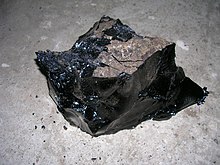
Back Gudrón AN بتومين Arabic Betún AST Bitum Azerbaijani قیر AZB Битум Bashkir Бітум Byelorussian Бітум BE-X-OLD Битум Bulgarian Bitumen BS



Bitumen (UK: /ˈbɪtʃʊmɪn/ BIH-chuum-in, US: /bɪˈtjuːmɪn, baɪ-/ bih-TEW-min, by-)[1] is an immensely viscous constituent of petroleum. Depending on its exact composition it can be a sticky, black liquid or an apparently solid mass that behaves as a liquid over very large time scales. In American English, the material is commonly referred to as asphalt. Whether found in natural deposits or refined from petroleum, the substance is classed as a pitch.[2] Prior to the 20th century, the term asphaltum was in general use.[3] The word derives from the Ancient Greek word ἄσφαλτος (ásphaltos), which referred to natural bitumen or pitch. The largest natural deposit of bitumen in the world is the Pitch Lake of southwest Trinidad, which is estimated to contain 10 million tons.[4]
About 70% of annual bitumen production is destined for road construction, its primary use.[5] In this application, bitumen is used to bind aggregate particles like gravel and forms a substance referred to as asphalt concrete, which is colloquially termed asphalt. Its other main uses lie in bituminous waterproofing products, such as roofing felt and roof sealant.[6]
In material sciences and engineering, the terms asphalt and bitumen are often used interchangeably and refer both to natural and manufactured forms of the substance, although there is regional variation as to which term is most common. Worldwide, geologists tend to favor the term bitumen for the naturally occurring material. For the manufactured material, which is a refined residue from the distillation process of selected crude oils, bitumen is the prevalent term in much of the world; however, in American English, asphalt is more commonly used. To help avoid confusion, the terms "liquid asphalt", "asphalt binder", or "asphalt cement" are used in the U.S. to distinguish it from asphalt concrete. Colloquially, various forms of bitumen are sometimes referred to as "tar", as in the name of the La Brea Tar Pits.[7]
Naturally occurring bitumen is sometimes specified by the term crude bitumen. Its viscosity is similar to that of cold molasses[8][9] while the material obtained from the fractional distillation of crude oil boiling at 525 °C (977 °F) is sometimes referred to as "refined bitumen". The Canadian province of Alberta has most of the world's reserves of natural bitumen in the Athabasca oil sands, which cover 142,000 square kilometres (55,000 sq mi), an area larger than England.[10]
- ^ Jones, Daniel (2011). Roach, Peter; Setter, Jane; Esling, John (eds.). Cambridge English Pronouncing Dictionary (18th ed.). Cambridge University Press. ISBN 978-0-521-15255-6.
- ^ "CPC Definition – C10C Working-up Pitch, Asphalt, Bitumen, Tar; Pyroligneous Acid". Classification Resources. United States Patent and Trademark Office. November 2016. Retrieved 12 August 2023.
- ^ Abraham, Herbert (1938). Asphalts and Allied Substances: Their Occurrence, Modes of Production, Uses in the Arts, and Methods of Testing (4th ed.). New York: D. Van Nostrand Co., Inc.
- ^ Nag, Oishimaya Sen (17 February 2021). "The unique pitch lakes of the world". World Atlas. Retrieved 12 March 2021.
- ^ "Asphalt Applications". mineralproducts.org. Retrieved 22 January 2022.
- ^ Sörensen, Anja; Wichert, Bodo (2009). "Asphalt and Bitumen". Ullmann's Encyclopedia of Industrial Chemistry. Weinheim: Wiley-VCH. doi:10.1002/14356007.a03_169.pub2. ISBN 978-3-527-30673-2.
- ^ Brown, E. R.; Kandhal, P. S.; Roberts, F. L.; Kim, Y. R.; Lee, D.-Y.; Kennedy, T. W. (1991). Hot Mix Asphalt Materials, Mixture Design, and Construction (Third ed.). Lanham, Maryland: NAPA Education and Research Foundation. ISBN 978-0-914313-02-1.
- ^ "Oil Sands Glossary". Oil Sands Royalty Guidelines. Government of Alberta. 2008. Archived from the original on 1 November 2007.
- ^ Walker, Ian C. (1998), Marketing Challenges for Canadian Bitumen (PDF), Tulsa, OK: International Centre for Heavy Hydrocarbons, archived from the original on 13 March 2012,
Bitumen has been defined by various sources as crude oil with a dynamic viscosity at reservoir conditions of more than 10,000 centipoise. Canadian "bitumen" supply is more loosely accepted as production from the Athabasca, Wabasca, Peace River and Cold Lake oil-sands deposits. The majority of the oil produced from these deposits has an API gravity of between 8° and 12° and a reservoir viscosity of over 10,000 centipoise although small volumes have higher API gravities and lower viscosities.
- ^ "ST98-2015: Alberta's Energy Reserves 2014 and Supply/Demand Outlook 2015–2024" (PDF). Statistical Reports (ST). Alberta Energy Regulator. 2015. Archived from the original (PDF) on 30 April 2019. Retrieved 19 January 2016.